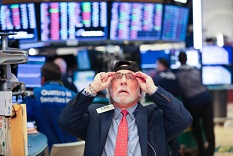USA Today: A bear market still lurks despite this week stock rally on the Dow

Article by Adam Shell and Paul Davidson in USA Today
Wall Street’s nearly 10-year-old bull is on the ropes despite this week's historic rally. A dreaded bear market, while not quite official yet, is hovering in the shadows.
Day after day of big losses and regular daily swings of 500 points or more in the Dow Jones industrial average – not to mention the market’s worst December since 1931 -- all are symptoms of a struggling market. This week’s head-spinning ups and downs in the market only add to investors’ angst and confusion.
“I don’t think we’re there yet,” Ameriprise Chief Investment Strategist David Joy said of a bear-market mentality. “But there are worrisome signs,” especially the sharp drop in consumer confidence this month.
What’s a bear market?
So what is a bear market? It is a period of declining stock prices in which a broad market gauge like the S&P 500 falls 20 percent from a prior high. Bears normally are caused by a recession, wildly optimistic investors, ridiculously overpriced stocks or interest rate shocks that cause economic contractions.
These steep sell-offs typically mark the end of good times. On average, these bear market drops, which are feared by investors, last 21 months and result in 40 percent declines, according to an S&P Dow Jones Indices analysis of the 13 S&P 500 bear market since 1929.
The continued slide in stock prices means the pain in investor portfolios is spreading and adding up to real money.
After more than a decade of rising stock prices aided by cheap money and zero percent interest rates provided by the Fed, the market is undergoing a violent shakeout. That's because the central bank has started draining stimulus from the system, and that pushes rates back to more normal levels.
The list of companies already mauled by the bear reads like a Who’s Who of American business: General Electric; Federal Express; Facebook; Ford; Apple, Amazon, Home Depot and Target, to name a few.
Spreading pain in stock market
The market gloom is even more widespread than investors might realize. In the latest sign of trouble, the technology-packed Nasdaq, entered a bear market this month.
Small-company stocks, measured by the Russell 2000 index, which is often viewed as a proxy for how much risk investors are willing to take, is already in bear territory.
The list of worries confronting investors is growing, and that’s causing stock prices to tumble as investors price in more risks.
The Fed’s latest rate decision has raised fears that rising borrowing costs will turn out to be a policy mistake that will deliver a knockout blow to the economy. Add to that the unease caused by a partial U.S. government shutdown Friday at midnight, the fallout and uncertainty tied to the U.S.-China trade fight, the massive plunge in U.S. oil prices and slowing growth in key global economies like Europe and China, and the case can be made for investors taking less risk in their stock and 401(k) portfolios.
A number of high-profile Wall Street pros have already declared the return of the bear.
Michael Wilson, equity strategist at Morgan Stanley, is calling the rout a “rolling bear market.” Jeffrey Gundlach, the so-called “Bond King” and founder of investment firm DoubleLine Capital, told CNBC that “I’m pretty sure this is a bear market.”
Bank of America Merrill Lynch’s global strategist Michael Harnett agrees, but says the bear market is “global” in nature. Even ex-Fed chairman Alan Greenspan, who alerted of “irrational exuberance” in the stock market 22 years ago, recently warned that, while stocks could still rise from current levels, investors should “run for cover” when this bull eventually ends.
How bad can things get?
It is impossible to predict how far stocks will fall and when they will hit bottom. But a review of past bear markets provides a guide of what investors can expect.
In the 2007-09 bear set in motion by the 2008 financial crisis, the S&P 500 cratered nearly 57 percent. And after the Internet stock bubble burst in 2000, stocks fell 49.1 percent.
And while this December’s steep stock decline is the worst since the Great Depression, it would take a true market collapse for the S&P 500 to match its record-setting 86.2 percent mauling it suffered from 1929 through 1932.
To read this article in USA Today in its entirety, click here.